Discover 25 animals in Cleveland National Forest through our hiking adventures! Dive into trails, photos, encounters, and responsible viewing tips.
Pack your hiking boots and binoculars! Cleveland National Forest, Southern California’s natural gem, is calling. Just a hop away from the city’s hustle and bustle, it’s where nature throws a party every day.
With trails sneaking through dense forests and sunlit meadows, each trek feels like unwrapping a gift. And oh, the wildlife! From the playful raccoon to the majestic mountain lion, the forest pulses with life.
Curious about our encounters? This isn’t just a list—it’s our diary of face-to-furry-face moments with Cleveland’s wild residents.
Alongside each tale, we spill the beans on the best trails to bump into these creatures and sprinkle in golden nuggets on how to cherish these moments responsibly. So, ready for a whirlwind tour through nature’s wonderland? Let’s lace up and set forth!
Mule Deer
Mule Deer are an iconic presence in the Cleveland National Forest, effortlessly recognized by their large, mule-like ears and forked antlers.
Their sleek, sand-colored coats blend seamlessly with the forest’s brushy terrains, making them masters of camouflage.
You’re most likely to catch sight of these graceful creatures near the open meadows, especially if you find yourself on the Tenaja Falls Trail or sections of the Pacific Crest Trail.
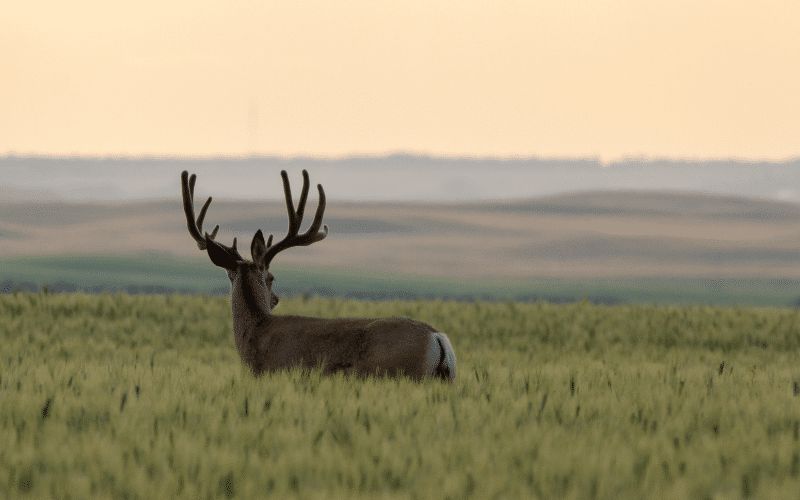
Interestingly, while mule deer are solitary for most of the year, they often come together in herds during winter, a spectacle that many hikers hope to witness.
Their diet primarily consists of shrubs and saplings, which are abundant within the forest. With every step in the Cleveland National Forest, you’re potentially walking in the quiet footsteps of a mule deer.
California Quail
Darting through the scrub and low bushes, the California Quail is a bird every hiker wishes to spot. Their distinctive teardrop-shaped topknot feather, combined with their blue-grey plumage, makes them stand out, even in the dense foliage.
The Agua Tibia Wilderness and Dripping Springs Trail provide favorable habitats for these social birds. California Quails are ground dwellers and are often seen in groups, called “coveys.”
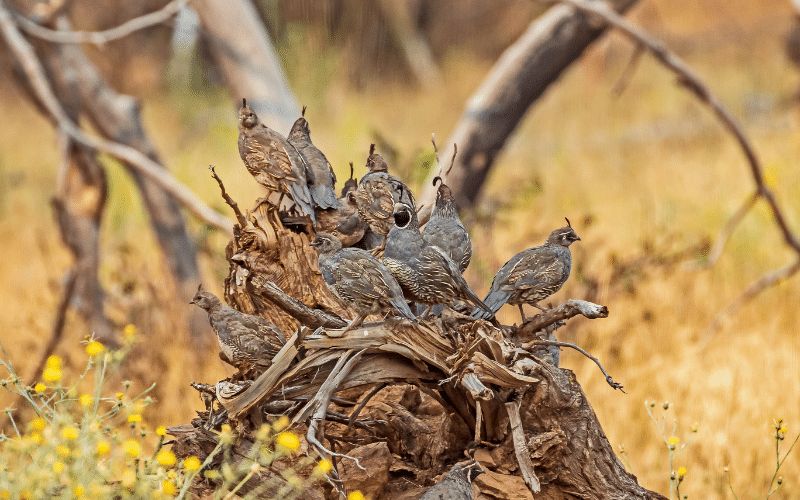
An interesting behavior unique to the quails in the Cleveland National Forest is their sentinel routine. One quail stands guard atop a tall shrub, keeping an eye out for predators, while the others forage below.
As you meander through the forest’s trails, you might be lucky enough to hear their distinctive “Chi-ca-go” call, a gentle reminder of nature’s harmonious melodies.
American Black Bear
Although the American Black Bear’s presence in the Cleveland National Forest is elusive, its aura is unmistakable.
These bears are characterized by their robust build and thick black fur, often with a slight brownish or cinnamon hue.
A unique feature some might not know is that black bears can occasionally be white or even blue-gray, depending on their genetics.
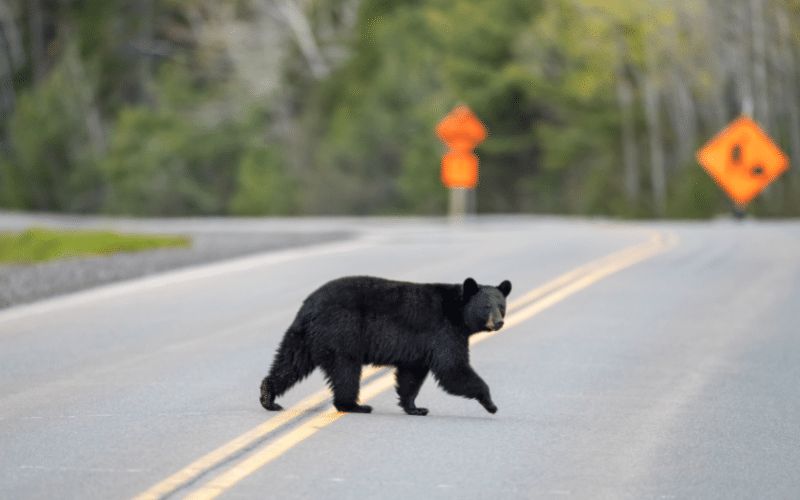
In the forest, your best bet of catching a distant glimpse would be in the more remote and dense sections, far from the frequently trodden trails.
The lore around them in the Cleveland National Forest is vast, with many long-time hikers sharing tales of brief, distant sightings or the unmistakable signs of their foraging activities.
Their diet in this forest primarily consists of berries, nuts, insects, and the occasional fish from the forest’s freshwater streams.
Mountain Lion
The Mountain Lion, also known as the cougar, holds a revered and almost mythical status within the Cleveland National Forest.
With a sleek body covered in tawny fur and a long, rope-like tail, their appearance is both majestic and intimidating.
These apex predators are predominantly nocturnal and are incredibly elusive, often leaving behind only a trace of their presence through tracks or territorial markings.
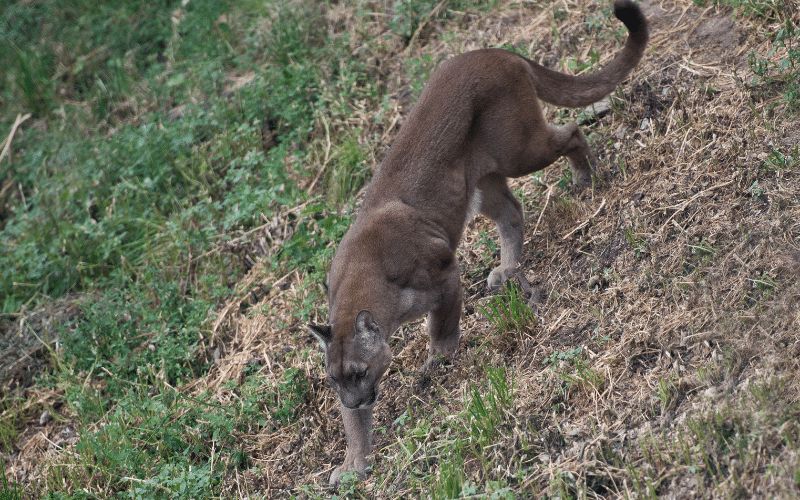
Several trails, especially those winding through the Trabuco Canyon or near the Agua Tibia Wilderness, have stories of rare sightings, usually at dawn or dusk.
Though sightings are scarce, their presence is felt throughout the forest, playing a crucial role in maintaining the ecological balance.
If you ever chance upon one, even if just a fleeting glimpse, it’s an encounter to cherish, for they truly embody the wild spirit of the Cleveland National Forest.
Coyote
The coyote is an emblematic figure of the North American wilderness, and its presence in the Cleveland National Forest is unmistakable.
These adaptable creatures sport a lean build with a coat that varies from gray to brown, often mixed with patches of white and dark fur.
Their pointed ears and sharp snout lend them a distinct profile. The coyote’s hauntingly beautiful howl can often be heard echoing through the forest, especially during dawn and dusk.
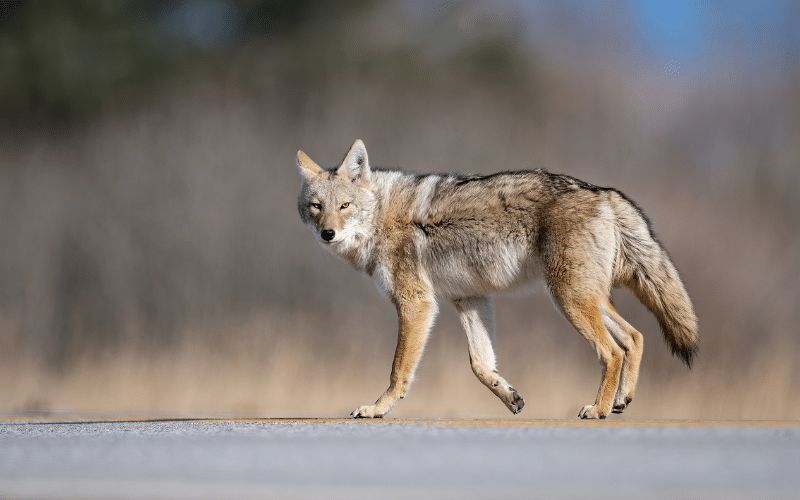
The Pine Creek Wilderness and the surrounding areas are known spots where hikers have observed them.
Intriguingly, in the Cleveland National Forest, coyotes have been spotted not just in their solitary majesty but also working in packs when hunting larger prey or defending their territory.
Their diet is varied, often scavenging, but they are skilled hunters, taking down rodents and even deer.
Red-tailed Hawk
Soaring high above the canopies of the Cleveland National Forest, the Red-tailed Hawk is a sight to behold for birdwatchers and hikers alike.
With a broad wingspan and a distinct reddish-brown tail, they are one of the most recognizable raptors in North America.
Their piercing eyes are always on the lookout for prey, which includes small mammals, birds, and reptiles.
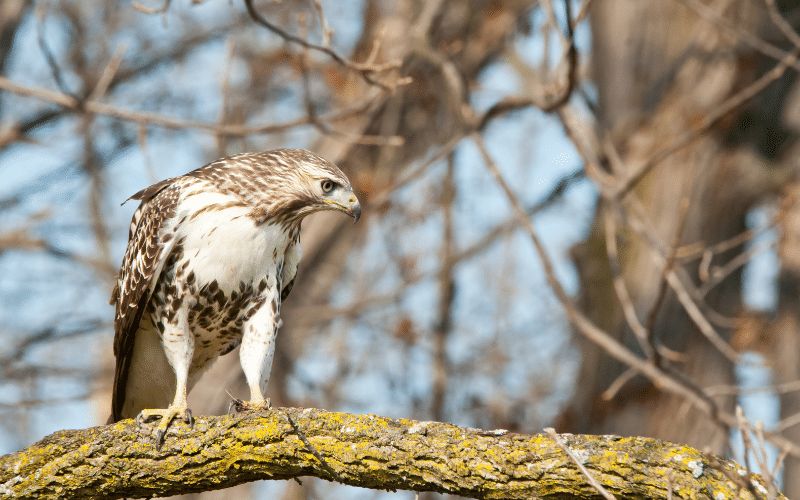
The open spaces near the Laguna Meadow and sections of the Pacific Crest Trail offer unobstructed views of their aerial maneuvers.
An interesting observation within the forest is their unique relationship with smaller birds. It’s not uncommon to see smaller birds mobbing a Red-tailed Hawk in defense of their territory.
The hawk’s sharp call, a downward-pitched scream, is often emblematic of the wild spirit of the Cleveland National Forest.
Raccoon
The mischievous raccoon, with its iconic black mask and ringed tail, is a nocturnal resident of the Cleveland National Forest.
These adaptable creatures have a grayish coat that provides perfect camouflage against the forest’s dense underbrush.
Raccoons are known for their dexterous paws, which they use with almost human-like precision to forage for food and explore their environment.
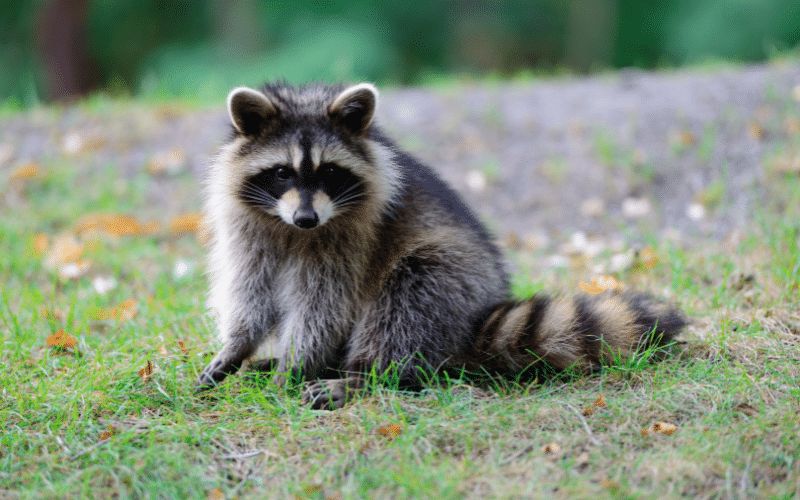
Along the shaded banks of the San Juan Creek or near the campgrounds, they can often be spotted rummaging during the night.
In the Cleveland National Forest, they have a varied diet, from fruits and plants to smaller creatures.
Though they might look adorable, it’s essential for visitors to remember that raccoons are wild animals.
Secure your belongings and food when camping to prevent any surprise raccoon visits.
American Marten
The American Marten, a lesser-known gem of the Cleveland National Forest, is a small and agile carnivore.
With a slender body covered in golden-brown to dark brown fur and a distinctive bushy tail, martens move with a graceful agility through the trees.
They’re most active during the twilight hours, making them a rare but delightful sighting for the patient observer.
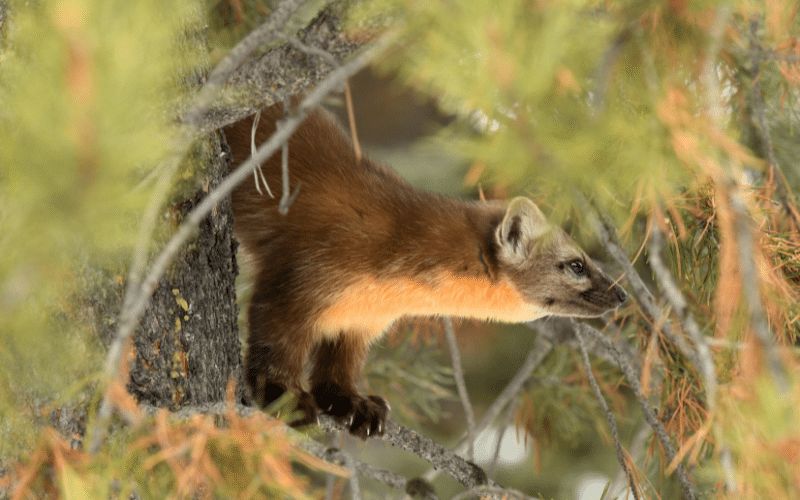
The dense, older growth regions around the Agua Tibia Wilderness offer a suitable habitat for them.
These martens are adept climbers and often pursue their prey, like squirrels and birds, into the treetops.
Interestingly, in the Cleveland National Forest, their diet also includes fruits and nuts, showcasing their adaptability to the environment.
Grey Squirrel
Among the rustling leaves and dappled sunlight of the Cleveland National Forest, the Grey Squirrel is a common yet delightful sight.
Covered in a soft coat of grey fur, often with warmer brown tones on their backs and tails, these squirrels are a burst of energy.
Their bushy tails are not just iconic but serve as a balancing tool when they scamper up and down trees.
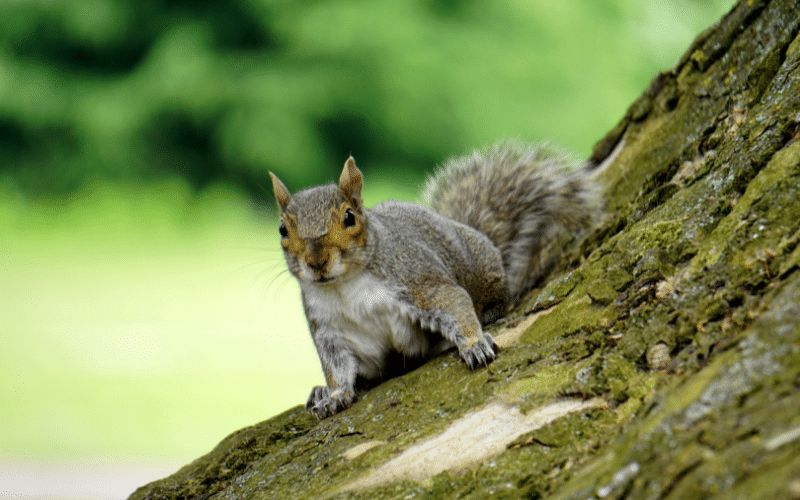
Frequented trails like the Holy Jim and the Silverado Canyon are places where hikers often spot them, foraging or playfully chasing one another.
In the forest, their diet mainly consists of acorns and seeds. An interesting adaptation of the Grey Squirrels in the Cleveland National Forest is their caching behavior, where they store food for leaner times.
It’s a fascinating spectacle watching them bury their treasure or find a previously hidden stash.
Western Fence Lizard
The sun-soaked trails and rocky outcrops of the Cleveland National Forest serve as a basking spot for the Western Fence Lizard.
Recognizable by its spiny, scaly back and the ability to change colors, this lizard is often referred to as the “blue-belly” due to the striking blue patches on its underside.
Popular areas such as the Ortega Falls or the Tenaja Falls Trail offer prime spots for observers to witness them soaking up the sun.
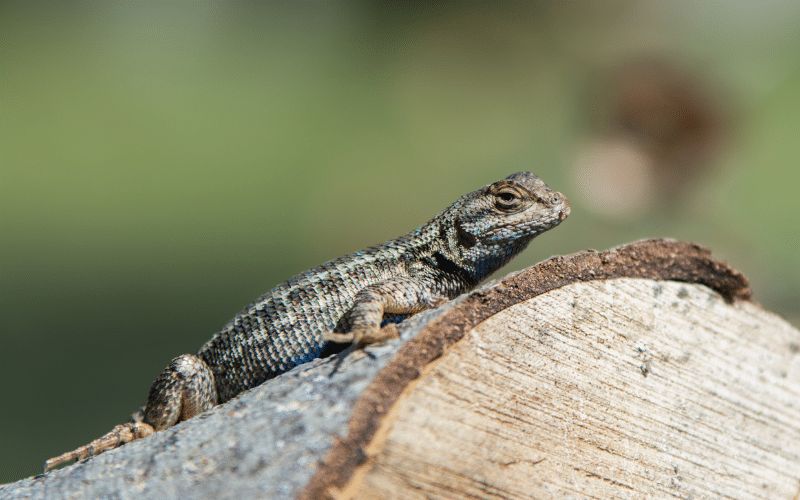
They play a vital role in the ecosystem by feeding on insects, thus helping control pest populations.
A unique aspect of the Western Fence Lizards in the Cleveland National Forest is their push-up display, a behavior exhibited by males to ward off rivals and attract potential mates.
It’s a small but intriguing dance of nature that, if you’re lucky, you might catch on one of your hikes.
Band-tailed Pigeons
Band-tailed Pigeons are a striking presence in the Cleveland National Forest, setting them apart from the common urban pigeons.
With a sleek gray body, they’re easily identifiable by their iridescent greenish nape and a distinctive white band on their tail, from which they derive their name.
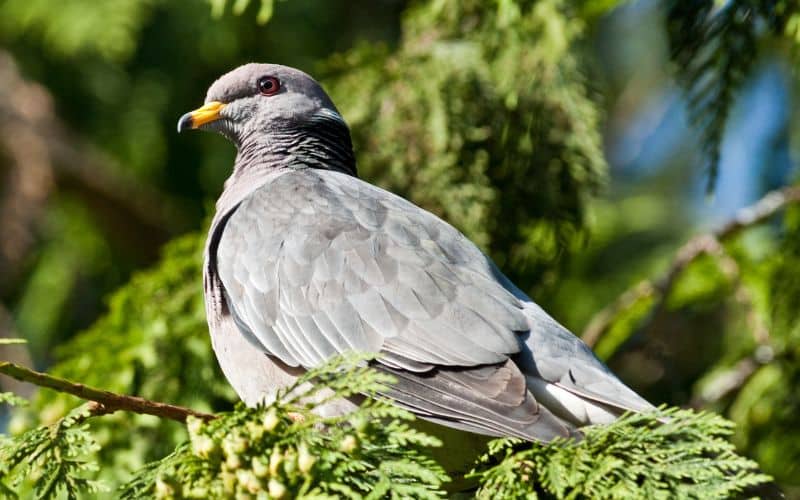
The canopies of old-growth conifers in regions like the Palomar Mountain area serve as their primary habitat, where they feed on a diet of seeds, berries, and fruits.
These pigeons are known to travel in flocks, and during certain times of the year, you can witness them congregating around natural mineral springs in the forest, seeking essential nutrients.
Their soft cooing, echoing through the forest, adds an auditory delight to any hike.
Mourning Dove
Mourning Doves, with their slender bodies and long pointed tails, bring a gentle elegance to the Cleveland National Forest.
Their soft gray-brown plumage and the characteristic black spots on their wings make them easy to identify.
Their melancholic cooing, which gives them their name, can be a soothing backdrop to the forest’s soundscape.
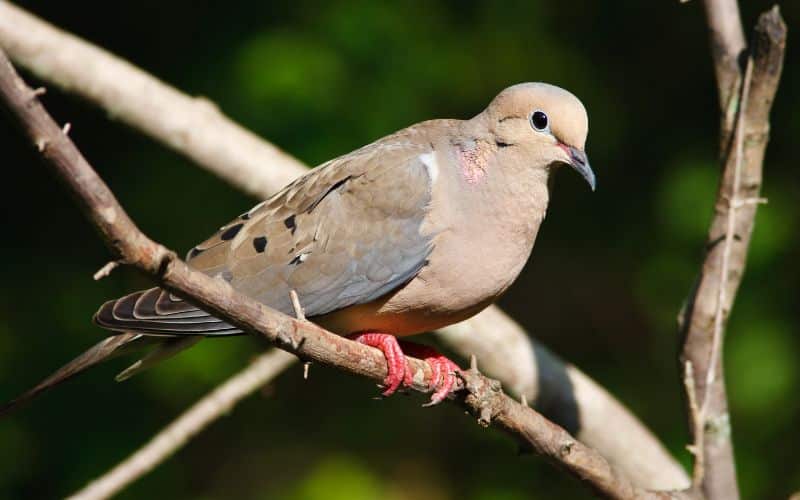
The open woodlands and edges of the meadows, particularly near areas like the Corte Madera Mountain, provide ideal habitats.
What’s intriguing about the Mourning Doves in this forest is their rapid flight pattern; they can burst into speedy flight, making a whistling sound with their wings, especially if startled.
Their diet mainly consists of seeds, which they forage off the ground in classic dove-fashion.
Brush Rabbits
The shy and elusive Brush Rabbit is a smaller species of cottontail commonly found in the thickets of the Cleveland National Forest.
With a soft brown-gray fur and a characteristic white tail, they blend seamlessly with the underbrush.
The denser vegetative regions, like those surrounding the Cottonwood Creek, are where they can often be spotted nibbling on green vegetation.
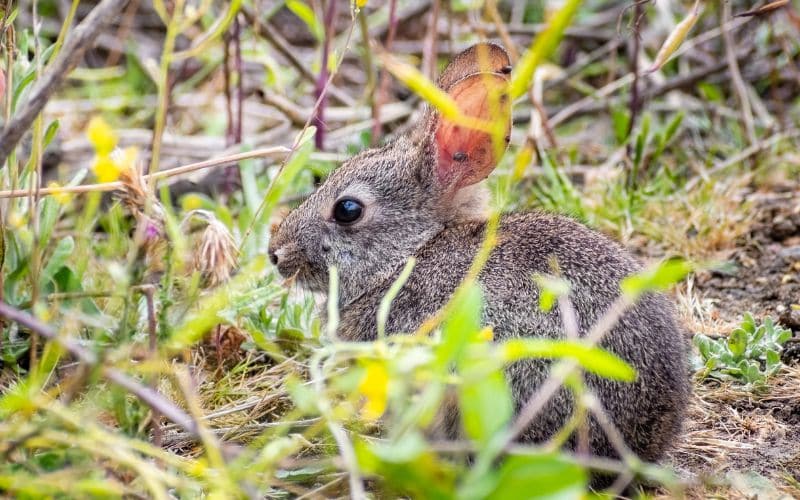
Unlike some other rabbit species, Brush Rabbits prefer staying close to the ground, seldom venturing far from thick cover.
This behavior is an adaptation to evade the many predators of the forest.
A peculiar trait seen among Brush Rabbits in the Cleveland National Forest is their habit of creating well-worn trails or “runways” in the underbrush, which they use to escape potential threats quickly.
Turkey
The wild turkeys of Cleveland National Forest are a sight to behold.
With shimmering feathers that range from bronze to green, and their characteristic fan-like tails, these birds bring a grandeur to the forest landscape.
Areas like the Pine Valley Creek and surrounding woodlands often echo with their gobbles, especially during the spring mating season.
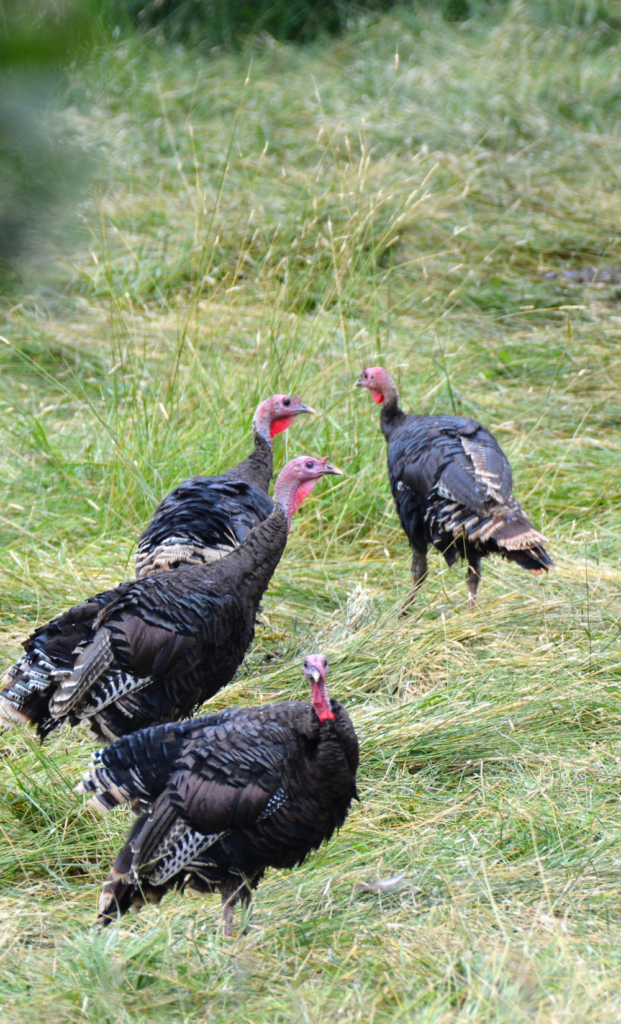
Unlike their domesticated counterparts, wild turkeys in the forest are agile flyers and often roost in trees at night.
They’re omnivorous, feasting on a mix of acorns, seeds, insects, and even small reptiles.
A fascinating aspect of the turkeys here is their communal behavior; it’s not uncommon to see groups, or “rafters,” of turkeys moving together, especially during foraging.
Cottontail Rabbits
Cottontail Rabbits are a frequent sight in the open spaces of the Cleveland National Forest, especially during the early morning or late evening hours.
Their soft brown fur, large ears, and the characteristic white “cottontail” make them instantly recognizable.
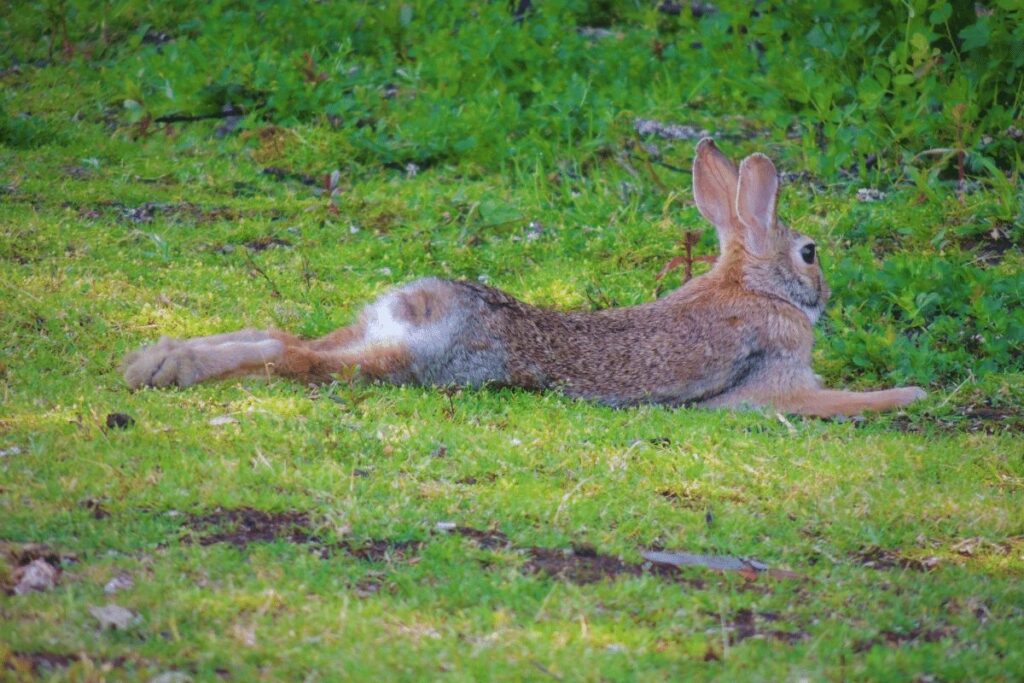
Areas with a mix of open grasslands and shrubbery, like the regions near the Ortega Highway, offer ideal habitats.
These rabbits are herbivores, often seen nibbling on grasses and herbs.
They have a peculiar habit of freezing when they sense danger, relying on their camouflage to protect them from predators.
Jack Rabbits
Easily distinguishable by their oversized ears, Jack Rabbits are not true rabbits but hares.
They inhabit the more arid and open areas of the Cleveland National Forest, especially around the Santa Rosa Plateau.
Their long, powerful legs are built for speed, and it’s an impressive sight watching a Jack Rabbit sprint across the landscape, reaching speeds up to 40 mph.
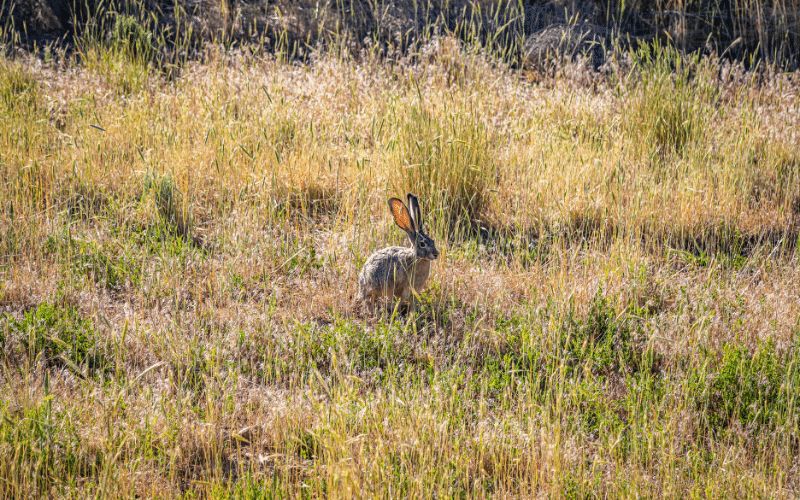
Their large ears not only aid in acute hearing but also help regulate their body temperature in the forest’s warmer regions.
They primarily feed on various vegetation, including grasses, herbs, and shrubs.
An interesting behavior observed among Jack Rabbits is their boxing matches, especially among males during the mating season.
Wild Pig
Roaming the rugged terrains of the Cleveland National Forest are the Wild Pigs, often considered the forest’s ecological architects.
They are an invasive species and are known to create problems for native wildlife.
With their compact, muscular bodies covered in bristly hair that ranges from dark brown to black, they’re easy to distinguish.
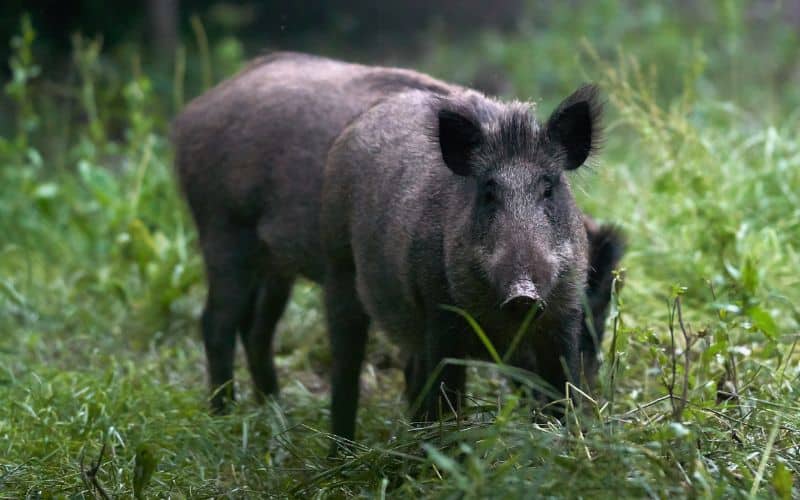
While they’re not native to the region, they’ve established a significant presence, especially in areas with abundant water sources.
The ravines and oak woodlands near the De Luz Creek are often frequented by these animals. Their omnivorous diet includes roots, tubers, small mammals, and even snakes.
An interesting aspect of the Wild Pigs in the forest is their wallowing behavior.
They create mud baths to regulate their body temperature and ward off parasites, leaving behind distinct wallows that play a role in shaping the forest’s landscape.
Badger
With their distinctive white stripe running from their snout to their shoulders, and the contrasting black patches on their face, Badgers are one of Cleveland National Forest’s most unique inhabitants.
These stout-bodied mammals prefer the forest’s open grasslands and meadows, such as those around the Indian Flats area.
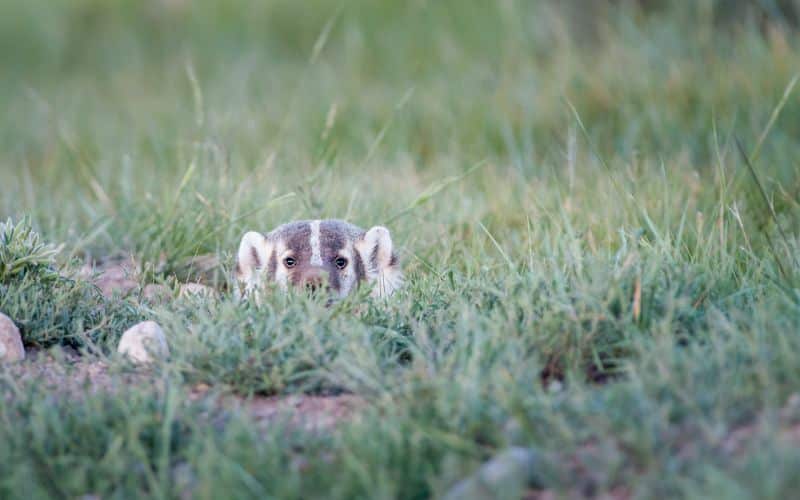
Badgers are nocturnal and spend much of their day underground in burrows, emerging at dusk to hunt.
Their diet consists mainly of ground-dwelling rodents, thanks to their keen sense of smell and strong forelimbs perfect for digging.
Interestingly, in the Cleveland National Forest, badgers have been observed in a mutualistic relationship with coyotes, hunting together to catch prey that might elude them individually.
Gray Fox
The Gray Fox, with its salt-and-pepper gray fur and rust-colored patches on its neck and legs, is a beautiful and agile inhabitant of the Cleveland National Forest.
These foxes are adept climbers, often found in the forest’s wooded areas, particularly around the Bear Canyon Loop.
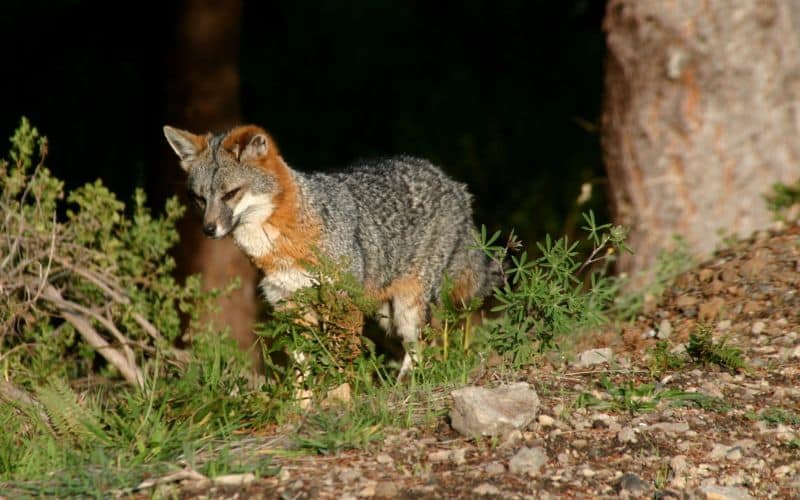
Unlike other fox species, Gray Foxes are known to climb trees, using their sharp claws to scale trunks and seek refuge or scout for prey.
Their diet is varied, including small mammals, birds, fruits, and insects.
A remarkable fact about the Gray Foxes in this forest is their monogamous nature. Pairs form strong bonds, often raising their young together in the cozy confines of their dens.
Black-tailed Deer
The Black-tailed Deer, a subspecies of the mule deer, is an elegant sight within the Cleveland National Forest.
Recognized by their stocky build and characteristic black-tipped tail, these deer gracefully navigate the forest’s terrains.
Their preferred habitats include the oak woodlands and chaparral shrublands, particularly prevalent around areas like the Tenaja Falls.
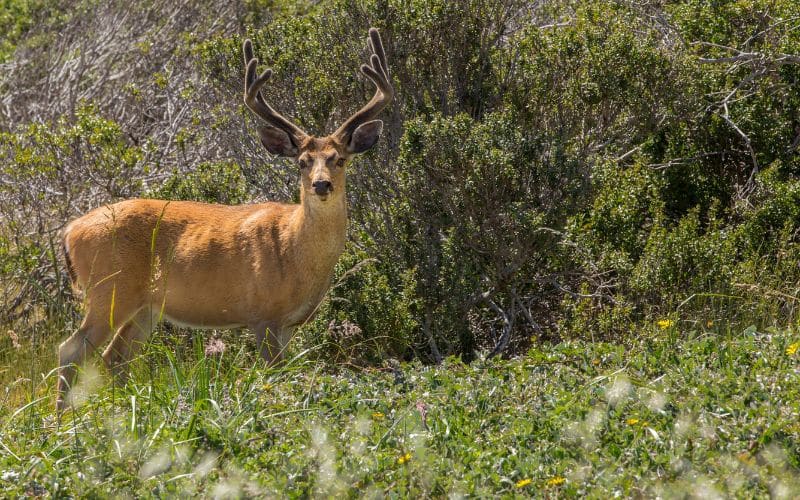
Their diet consists primarily of shrubs, supplemented by seasonal fruits and grasses. Notably, during autumn, you might observe them partaking in the ‘rut’ or mating season.
Males, or bucks, showcase impressive antler displays and occasionally engage in combative bouts, all in an attempt to secure a mate.
White-tailed Deer
Another deer species gracing the Cleveland National Forest is the White-tailed Deer, distinguishable by its prominent white, bushy tail which it raises like a flag when alarmed.
Their habitats often overlap with their Black-tailed counterparts, but they can be frequently spotted around the grassy clearings near the Corte Madera Mountain.

With a more reddish-brown hue in summer that turns greyish in winter, they easily blend with the seasonal shifts of the forest.
Their diet is a mix of grasses, herbs, and young shoots.
Interestingly, White-tailed Deer in the Cleveland National Forest have been observed to have a unique “bounding” gait when escaping predators, leaping high and covering significant ground quickly.
Bob Cat
The enigmatic Bob Cat, with its tufted ears, ruffed face, and short “bobbed” tail, prowls the understories and rocky terrains of the Cleveland National Forest.
These medium-sized cats possess a tawny coat with subtle spots, allowing them to camouflage effectively while stalking their prey.
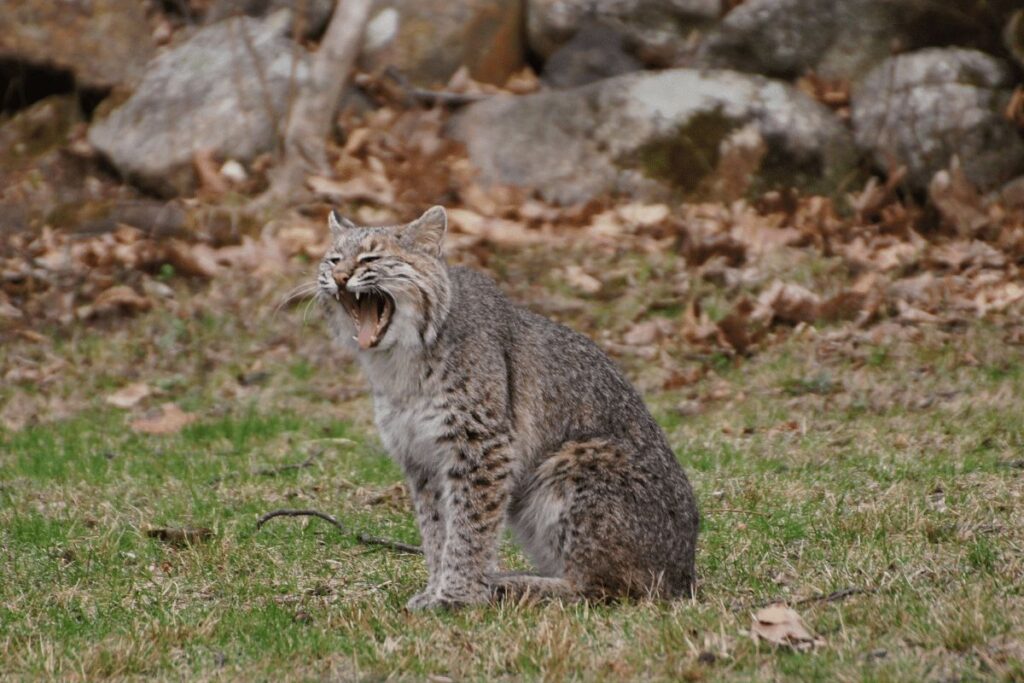
Areas around the Pine Creek Wilderness and Palomar Mountain are among their preferred habitats.
Primarily nocturnal, they feed on a varied diet of rabbits, rodents, birds, and even the occasional deer fawn.
An intriguing behavior exhibited by Bob Cats within the forest is their territorial marking.
They leave claw marks on trees and even create “scrapes” or patches of disturbed ground as a sign to other Bob Cats.
Opossum
The Opossum, often simply referred to as “possum”, is North America’s only marsupial and holds a unique place within the Cleveland National Forest ecosystem.
Sporting a pointed face, round dark eyes, and a prehensile tail, these nocturnal creatures are adept at navigating the forest floor and trees alike.
Areas abundant in dense undergrowth and proximity to water sources, like the vicinity of the San Mateo Creek, are favored by opossums.
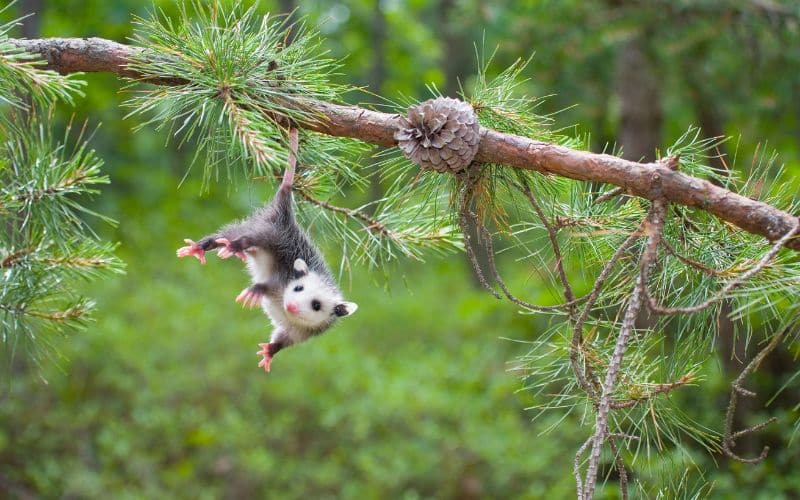
They are true opportunists when it comes to their diet, consuming everything from fruits and insects to small mammals and birds.
One fascinating aspect of the opossum is its immunity to many snake venoms, allowing it to prey upon various snake species within the forest without harm.
Skunks
With their distinctive black and white striped fur, skunks are both admired for their unique appearance and approached with caution due to their notorious defense mechanism.
The open woodlands and grassy meadows near the Corte Madera Mountain often play host to these nocturnal animals.
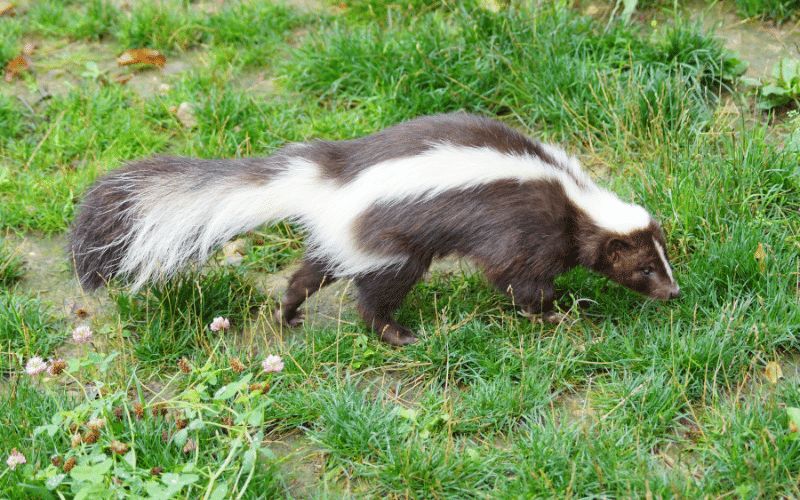
Their omnivorous diet includes berries, roots, insects, and smaller vertebrates.
An interesting behavior exhibited by skunks in the Cleveland National Forest is their “dance”, a series of jumps and postures used to intimidate potential threats.
And, of course, if this doesn’t work, they can deploy their infamous spray, a strong-smelling liquid that deters even the most persistent of predators.
Weasel
The nimble and elusive weasel is one of the lesser-seen inhabitants of the Cleveland National Forest but plays a crucial role in the ecosystem.
Characterized by their slender bodies, short legs, and sharp features, weasels have a reddish-brown fur that often turns white in winter climates, although this is less common in the milder climate of this forest.
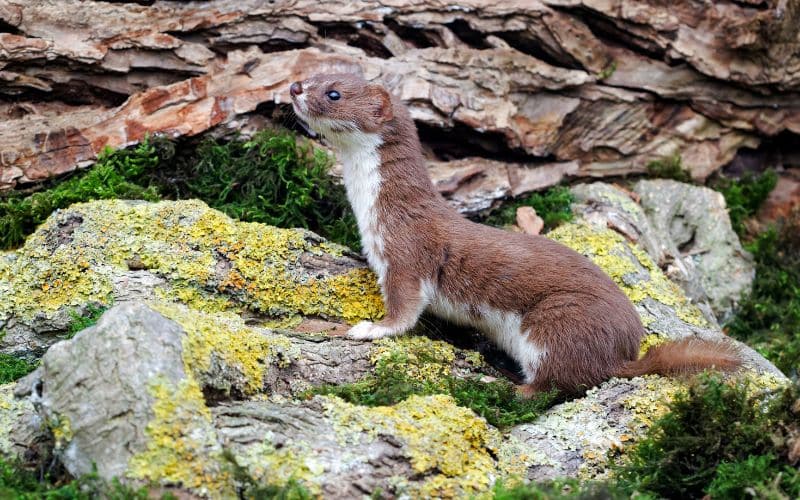
The dense underbrush and forest edges, especially around the Trabuco Canyon, are often where these agile predators hunt.
With a diet that primarily consists of rodents, they help control pest populations.
An endearing trait of weasels in the forest is their playful nature. They can sometimes be seen darting in and out of burrows or playfully chasing after their tails.
Hiking Trails to See Wildlife in Cleveland National Forest
Exploring the Cleveland National Forest is an unparalleled adventure for nature enthusiasts, especially those keen on spotting diverse wildlife in their natural habitats.
Among the vast expanses of this forest are trails that promise encounters with creatures big and small. Here are some of the notable trails we’ll delve into:
Pacific Crest Trail
The Pacific Crest Trail (PCT) is a jewel within the Cleveland National Forest and stretches far beyond it, running over 2,600 miles from Mexico to Canada.
Within the forest’s bounds, this trail traverses over 40 miles, promising a diverse palette of ecosystems and terrains.
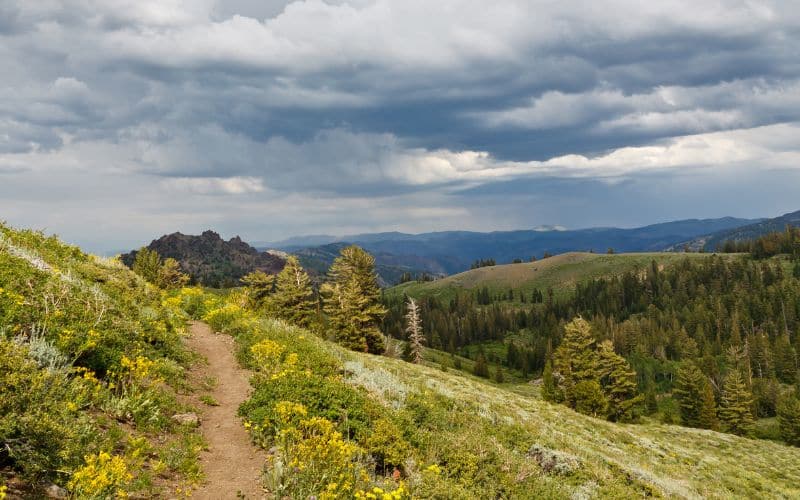
Starting near the desert-viewpoint, as you embark on this section of the PCT, the expansive vistas open up, revealing valleys, meadows, and thick woodlands.
Wildlife enthusiasts are in for a treat. Mule deer often graze the open fields, while the sharp-eyed might spot the elusive gray fox darting through the underbrush.
Above, the skies are frequented by various raptors, including the majestic Red-tailed Hawk and occasionally the Golden Eagle.
Flora along the trail is just as varied. Depending on the season, hikers can witness a vibrant display of wildflowers, or the golden hues of deciduous trees in the fall.
The trail offers varying degrees of difficulty, with some sections being more challenging, making it essential for hikers to be well-prepared.
For those wanting to immerse themselves in the experience, the trail provides access to several campgrounds.
Boulder Oaks and Burnt Rancheria are two popular ones, where the melody of nature continues long after sunset, under a canopy of stars.
The PCT in the Cleveland National Forest is more than just a hike; it’s an experience, a journey through nature’s myriad wonders, and a testament to the wild beauty of the American landscape.
Holy Jim Trail
The Holy Jim Trail, enveloped within the heart of the Cleveland National Forest, is a testament to nature’s grandeur and history.
Stretching approximately 2.8 miles round trip, this trail is renowned not just for its natural beauty but also for the tale behind its name, attributed to an eccentric beekeeper named “Holy Jim.”
As hikers set foot from the trailhead, the path unwinds through lush canyons, offering a verdant spectacle of ferns, oaks, and sycamores.
The ever-present sound of trickling streams accompanies one’s journey, culminating in the awe-inspiring Holy Jim Falls, a cascading marvel that beckons photographers and nature lovers alike.
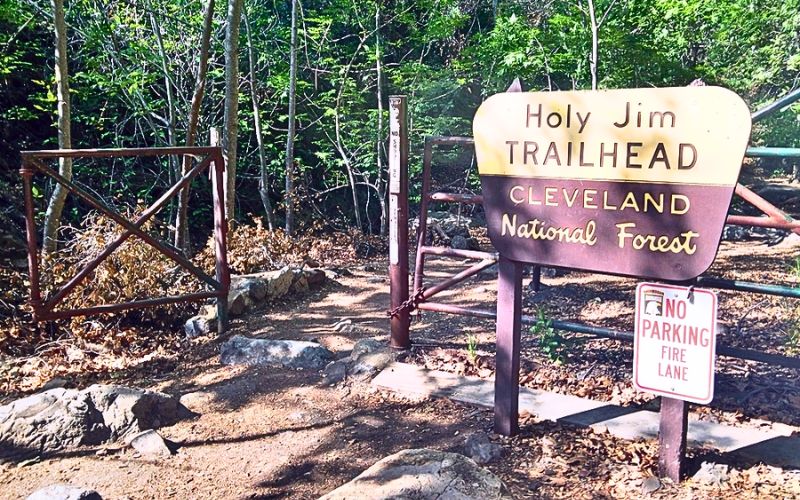
The trail’s dense vegetation serves as a haven for wildlife. From the nimble Western Fence Lizard sunning on rocks to the occasional bobcat stealthily moving through the underbrush, the trail promises an array of wildlife encounters.
Birdwatchers, too, are rewarded with sights of songbirds, woodpeckers, and the vibrant California Thrasher.
Given the trail’s moderate difficulty and varied terrains, hikers are treated to a blend of serene flat walks and challenging ascents, making every step an adventure.
For those wishing to extend their forest sojourn, nearby campgrounds, such as the Falcon Group Camp, provide an idyllic setting.
Here, campfires crackle under the starlit sky, and the forest’s nocturnal symphony takes center stage.
The Holy Jim Trail isn’t just a path through the woods; it’s a journey that intertwines nature’s splendor with the rich tapestry of local folklore, ensuring every hike is both a discovery and a delightful reminiscence.
Tenaja Falls Trail
Meandering through one of the most scenic pockets of the Cleveland National Forest, the Tenaja Falls Trail is a wonder that beckons hikers of all levels.
This relatively short trail, covering about 1.8 miles round trip, manages to pack in an astounding array of natural sights and sounds, culminating in the mesmerizing Tenaja Falls.
From the trailhead located off Cleveland Forest Road, one steps into a realm of dense canopies, intermittent sunlit glades, and the ever-present music of cascading waters.
The path is flanked by vibrant foliage, and depending on the season, the air is often filled with the sweet scent of blooming wildflowers like the purple lupine and golden California poppies.
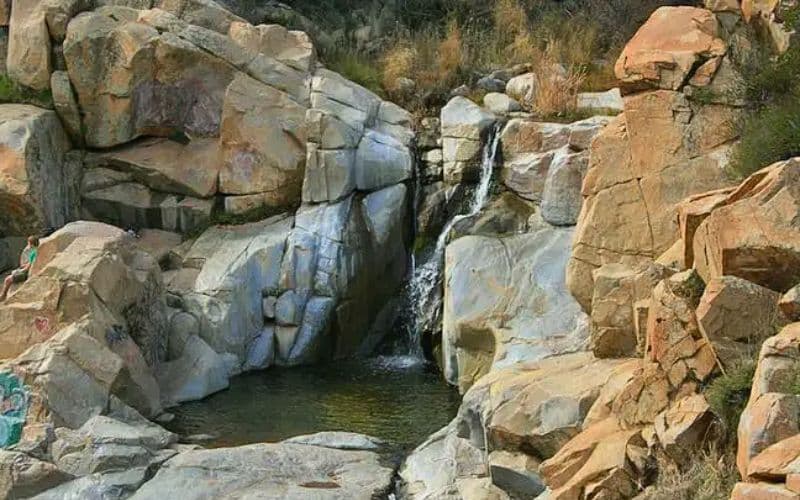
The trail is rich in wildlife. The chirping of songbirds fills the air, while keen observers might spot the graceful flight of the Red-tailed Hawk overhead.
Amphibians, especially after a rain, make their presence known near the water sources, and the elusive California Quail might be seen (or heard) rustling in the underbrush.
The star attraction, of course, is the Tenaja Falls itself. Depending on recent rains, this waterfall can be a gentle cascade or a roaring spectacle.
Its waters create serene pools, perfect for a moment of reflection or a refreshing dip on warmer days.
While the trail is favored by day-trippers, the nearby Fisherman’s Camp offers a rustic overnight experience for those wanting to bask in the forest’s ambiance a little longer. Here, the gentle sounds of the night remind one of the forest’s timeless beauty.
All in all, the Tenaja Falls Trail is a blend of serenity and grandeur, offering a slice of the Cleveland National Forest’s magic in a relatively short expanse.
Each footfall on this path is a step into nature’s embrace, making it a must-visit for anyone seeking a rejuvenating forest escapade.
Trabuco Canyon Trail
Deep within the heart of the Cleveland National Forest lies the Trabuco Canyon Trail, a path less trodden, offering an authentic wilderness experience.
Spanning roughly 7 miles round trip, this trail is a mosaic of rugged terrains, serene groves, and glimpses of the area’s rich history.
Initiating from the Trabuco Canyon Road trailhead, hikers are welcomed by a mix of tall chaparral and age-old oak trees, creating a dappled sunlight effect that’s both calming and visually captivating.
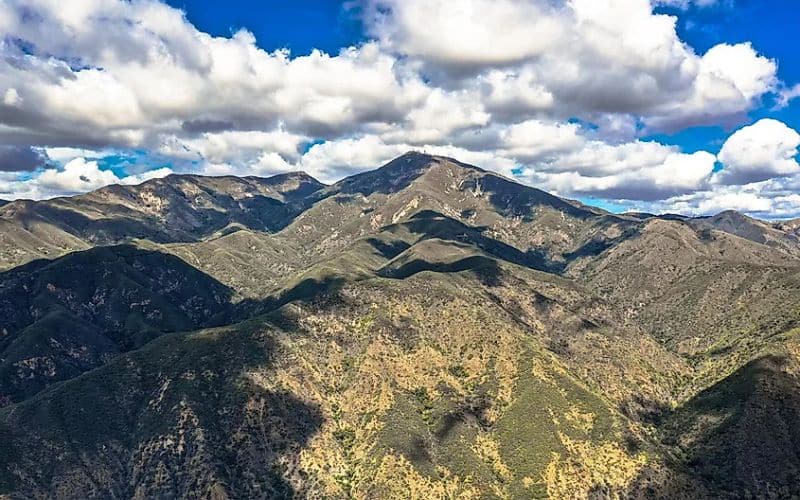
The trail often runs alongside Trabuco Creek, and the sound of flowing water provides a serene backdrop to the hike, particularly in the wetter months.
The canyon’s deep pockets and unique microclimates house a plethora of wildlife. Sightings of the nimble-footed mule deer are common, while the sharp calls of the Mountain Quail echo in the distant ridges.
The area is also a haven for reptile enthusiasts, with the Western Fence Lizard and various snake species making occasional appearances.
History buffs will appreciate remnants from the area’s mining past, with old mineshafts and rusted equipment hidden amongst the foliage, silently narrating tales of the bygone era.
The trail also offers stunning vistas of the Santa Ana Mountains, especially from higher vantage points.
The difficulty level of the Trabuco Canyon Trail can vary, with some stretches demanding careful navigation, especially after rains when the creek might need fording.
For those wishing to extend their wilderness experience, the nearby Trabuco Campground provides a rustic setting under a canopy of stars.
In essence, the Trabuco Canyon Trail is more than just a hike; it’s a journey back in time, an exploration of diverse habitats, and an intimate dance with the untamed beauty of the Cleveland National Forest.
Every twist and turn holds a new promise, ensuring that no two hikes are ever quite the same.
San Juan Loop Trail
Situated amidst the picturesque landscapes of the Cleveland National Forest, the San Juan Loop Trail offers a delightful escape into nature, suitable for hikers of all ages and abilities.
Covering a relatively modest 2.2 miles loop, this trail delivers an experience brimming with visual splendor and natural wonders.
Starting off from the trailhead near the Ortega Oaks Candy Store and the San Juan Ranger Station, the path meanders through a lush forest canopy, punctuated by ancient oaks and sycamores.
The perennial San Juan Creek adds to the trail’s charm, with its babbling waters and shimmering pools serving as a soothing constant throughout the hike.
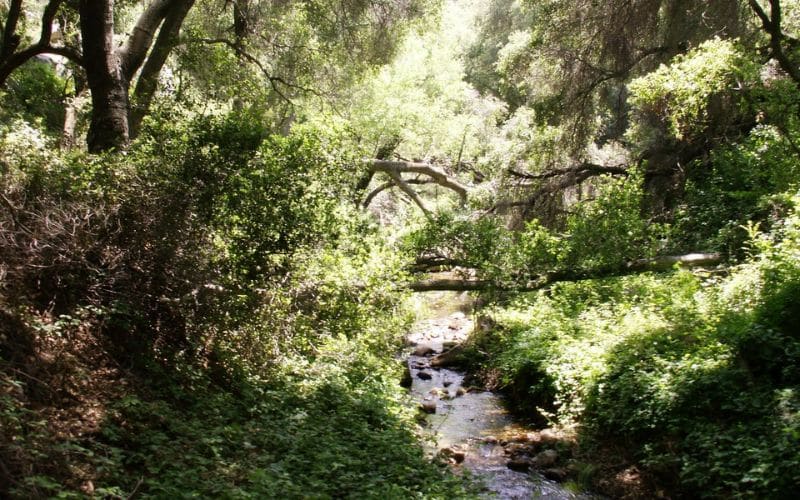
The area’s diverse ecology promises a rich tapestry of wildlife encounters. The gentle rustling of the underbrush might reveal a California quail, while the overhead canopies are often the playground of colorful songbirds.
The well-vegetated banks of the creek are also frequented by amphibians and the occasional gray fox during twilight hours.
Adding a touch of historical intrigue to the natural beauty are the remnants of early 20th-century mining operations, offering a glimpse into the region’s industrious past.
Several viewpoints along the trail provide panoramic vistas of the surrounding mountains, making for perfect photo opportunities.
Despite its shorter length, the San Juan Loop Trail can be quite dynamic, with gentle inclines, wooden bridges, and rocky stretches.
Nearby campgrounds, such as the Blue Jay Campground, provide an option for those wanting to extend their stay in the heart of the forest.
The San Juan Loop Trail is a microcosm of the Cleveland National Forest’s grandeur.
Whether it’s the allure of cascading waters, the vibrant chorus of forest dwellers, or the embrace of age-old trees, the trail promises a rejuvenating journey for the soul, making it an indispensable part of any forest expedition.
Corte Madera Mountain Trail
Ensconced in the southern realms of the Cleveland National Forest, the Corte Madera Mountain Trail offers a challenging yet rewarding adventure for the avid hiker.
Spanning approximately 7 miles round trip, this trail serves up an undulating landscape, where each ascent reveals ever-more breathtaking vistas.
Setting off from the trailhead located off Corral Canyon Road, the path winds through dense chaparral, interspersed with stately pine and oak trees.
The trail’s higher elevations provide panoramic views of the surrounding valleys, distant mountains, and, on clear days, even the shimmering Pacific Ocean.
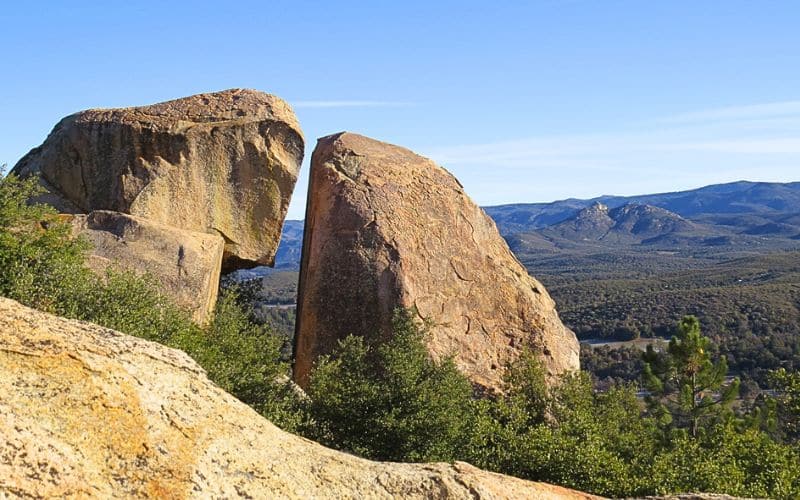
As one delves deeper into the trail, wildlife encounters become part of the journey’s tapestry. The White-tailed Deer is often spotted grazing in the clearings, while the keen-eyed might catch a glimpse of the elusive bobcat.
The dense foliage is a symphony of birdcalls, with woodpeckers, jays, and hawks adding to the trail’s auditory experience.
Unique rock formations dot the landscape, offering intriguing photo opportunities and natural rest spots.
The peak of Corte Madera Mountain, with its distinctive split rock and expansive lookout points, is undeniably the trail’s crowning glory.
Given the trail’s moderate to strenuous stretches, it’s essential for hikers to be well-prepared with ample water and provisions.
For those wanting to bask under the stars, the nearby Corte Madera Campground offers a serene setting amidst the forest’s embrace.
Bear Canyon Loop Trail
Nestled in the heart of the Cleveland National Forest, the Bear Canyon Loop Trail is a 6.5-mile circuit that promises diverse terrains, scenic vistas, and intimate encounters with the forest’s vibrant ecosystem.
From the trailhead off Ortega Highway, the path dips into the shaded embrace of Bear Canyon, with its cool microclimate and a seasonal creek that gurgles during the wetter months.
As the trail meanders, it unveils a medley of ecosystems, from dense woodlands to sunlit chaparral.
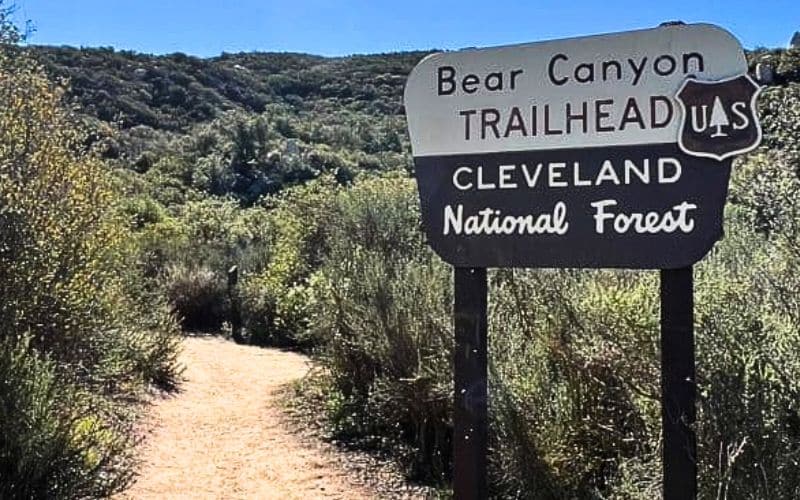
Wildlife is aplenty on this loop. From the playful antics of the grey squirrel to the soaring flight of the Red-tailed Hawk, nature’s drama unfolds at every bend.
The occasional rustling might reveal a raccoon or even the footprints of a mountain lion, a silent testament to the canyon’s wilder inhabitants.
The trail is punctuated by several viewpoints, from where one can drink in the vistas of the San Mateo Wilderness and distant mountain ranges.
The cascading waters of Bear Canyon Falls, especially after rains, add a touch of magic to the hike.
Given the trail’s varied landscapes, it’s suitable for hikers of different experience levels, though some stretches might demand a bit more agility.
Adjacent campgrounds, such as the El Cariso Campground, provide a perfect base for those wishing to extend their wilderness experience.
In its entirety, the Bear Canyon Loop Trail is a celebration of nature’s diversity, offering a wholesome and ever-changing forest experience that lingers in memory long after the hike is concluded.
12 Tips for Responsible Wildlife Viewing in Cleveland National Forest
When enjoying the majestic creatures of the Cleveland National Forest, it’s essential to respect their habitats and observe from a distance.
Here are some tips to ensure a safe and enjoyable experience:
- Stay on Designated Trails: The Cleveland National Forest boasts well-marked trails, designed to minimize human impact on delicate habitats. Stick to these paths to reduce disturbance to wildlife and their homes.
- Observe from a Distance: Many animals in the forest, like mountain lions and deer, are best admired from afar. Use binoculars or a camera with a zoom lens to get a closer look without approaching them.
- Avoid Feeding Wildlife: The natural diet of forest animals is vital for their health. Human food can be harmful and habituate them to human presence, potentially leading to problematic behavior.
- Tread Quietly: The forest’s serene environment allows for better wildlife sighting opportunities. Move quietly and speak softly, ensuring that animals aren’t startled or driven away.
- Travel in Small Groups: Large groups can be intimidating to wildlife. If possible, hike in smaller groups and ensure everyone understands the importance of respectful wildlife observation.
- Respect Nesting Sites: Birds like the California quail and raptors have nesting grounds within the forest. Be cautious not to disturb these areas, especially during breeding seasons.
- Avoid Nighttime Exploration: Many animals in the Cleveland National Forest are nocturnal. Avoid hiking or camping activities at night to reduce disturbances to their natural behaviors.
- Be Cautious Near Water Sources: Streams and ponds are vital resources for animals, especially in drier months. Approach water sources gently, keeping an eye out for wildlife and avoiding any interference with their drinking or bathing routines.
- Educate Yourself: The forest’s visitor centers, like the Trabuco Ranger District office, provide valuable insights and guidelines on local wildlife. Familiarize yourself with the animals you might encounter and their behaviors.
- Store Food Securely: When camping, ensure that all food items are stored in animal-proof containers and kept away from your sleeping area to avoid attracting wildlife to your campsite.
- Respect the “Leave No Trace” Principle: Ensure you take back everything you bring into the forest. Litter can be harmful to wildlife and negatively impact their natural behaviors.
- Report Any Concerns: If you notice injured wildlife or animals displaying unusual behavior, report it to forest officials or rangers. They’re equipped to handle such situations and ensure the safety of both the animals and visitors.
By adhering to these guidelines, visitors can ensure their experience in the Cleveland National Forest is not only memorable but also preserves the natural beauty and balance of this treasured ecosystem.
Conclusion
Exploring Cleveland National Forest was a great way to connect with nature and observe some amazing wildlife. We were able to take in the sights and sounds of this stunning forest while spotting 10 different species of animals along our hike.
Whether you’re looking for an adventure or just need some time away from the hustle and bustle, Cleveland National Forest is a great place to explore and appreciate the beauty of nature.
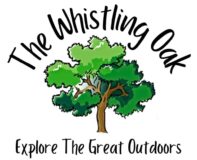
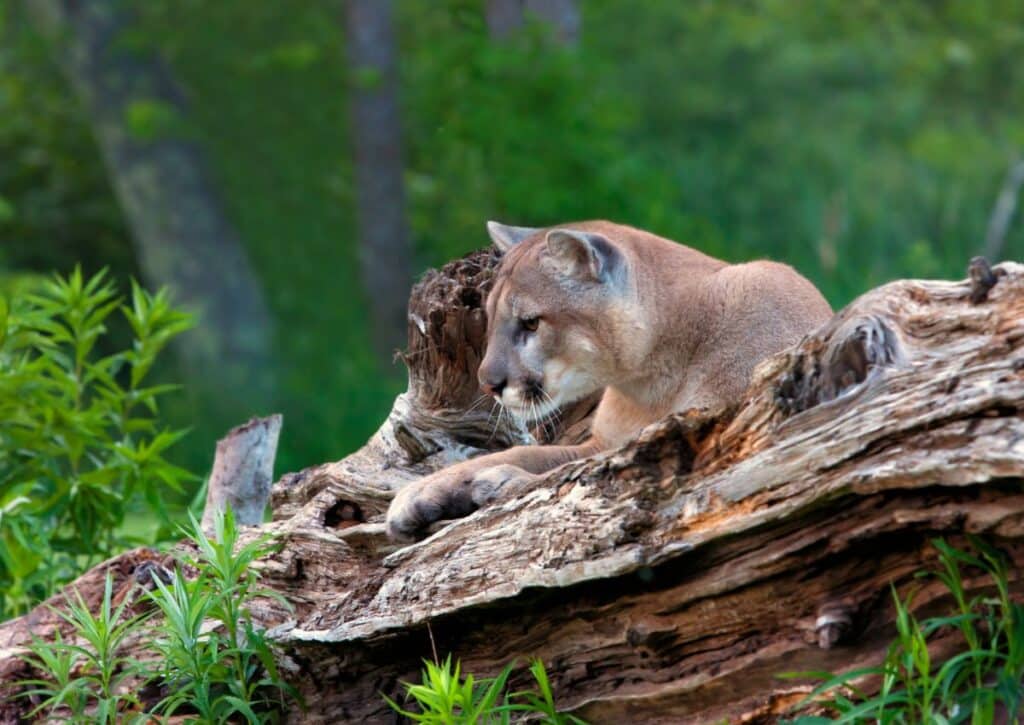
Is this an older post? There are
currently no bears on the Cleveland NF. The last confirmed siting of a bear was over ten years ago. There are however a healthy population in the neighboring San Bernardino NF.
Our Writer saw one crossing the road at the start of 2022!
However, will make a note of your observation in our title.
Thanks for keeping us in check!! appreciate!!